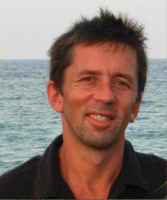An Interview with Steve Wilson
Posted by Eva Amsen, on 20 April 2010
(Interview by Kathryn Senior. Originally published in Development)
 Stephen Wilson is Professor of Developmental Genetics at University College, London, UK. He was recently awarded the Remedios Caro Almela Prize for Research in Developmental Neurobiology. We interviewed Steve to find out about how he started on the road to developmental biology research, how he got interested in the brain, his achievements and future challenges.
Stephen Wilson is Professor of Developmental Genetics at University College, London, UK. He was recently awarded the Remedios Caro Almela Prize for Research in Developmental Neurobiology. We interviewed Steve to find out about how he started on the road to developmental biology research, how he got interested in the brain, his achievements and future challenges.
What originally set you on the road towards a career in science?
I dropped biology at school and was all set to study metallurgy at University for no good reason at all. Luckily I realized this just before starting. The fact that the course was entirely populated by male students helped my decision-making… I took a year off, worked in a school lab and realized that I loved biology – that was the start.
You have chosen to focus on the most complex organ – the brain – what prompted that choice?
I went to Steve Easter’s lab as a post-doc to work on the developing eye and retino-tectal projection. You might say it was serendipity but the first time I tried to label retinal axons, I stuck the needle through the back of the eye and into the brain. I labelled lots of neurons that were not supposed to be there. My time as a post-doc was spent trying to find out more about these very early forebrain neurons – I’m still on the same mission.
What is the most frustrating challenge that you have had in your research and how did you tackle it?
Perhaps ‘frustrating’ is not the right adjective but a challenge that taught me a lot arose during my time as a post-doc. My closest friend at the time (with whom I shared an apartment) was working on essentially the same project as me but in a competing, neighbouring lab. This was quite a challenge for us to cope with. We both learned that friendship is far more important than the transient troubles one faces in the lab – most of which resolve and fade from memory in a few months.
Which scientist do you most admire?
I find that hero worship tends to lead to disappointment but I admire many individuals for many different qualities. I learned a lot from Nigel Holder. The most important thing he taught me was to put fun, friendship and a spirit of inquisitiveness right at the heart of our scientific investigations. I have no doubt that Nigel picked up the same ideas from his mentor Lewis Wolpert. At the age of 81, Lewis remains as enthusiastic about science as ever.
Do you feel that scientific research is a solitary pursuit or is it something that is best done with a team effort?
Scientists and scientific research are so diverse that there is no ‘best way’ to pursue science. Certainly some successful scientists work largely alone but I don’t think I am clever enough to achieve much on my own and I certainly wouldn’t enjoy trying. Teamwork does present challenges, but if team members are enthusiastic and value their roles and contributions, then the benefits are obvious.
If you could have the answer to one question that has been troubling you about development in the zebrafish brain, what would that be and why?
Where are the equivalents of the hippocampus, amygdala and cortex in the teleost brain and how do they arise? The dorsal telencephalon (pallium) of teleosts undergoes an unusual mode of morphogenesis that makes it a challenge – but not an impossible one – to determine homologies with pallial structures and neuronal populations in other vertebrate groups. A better understanding of telencephalic development, homologies and connectivity will be a big help for studies that are trying to unravel the development of higher brain functions.
What is the biggest challenge for maintaining your personal motivation and for finding a way forward when research problems seem particularly difficult?
Finding enough time in the day. This is probably the biggest challenge for most of us. We have far too much to do, not enough time, and as our careers progress, we accumulate more and more tasks and responsibilities. It is a real luxury to find unpressured time to sit and seriously think about research problems and how they might be solved. Such time is never wasted and one has to remember to give it the priority it deserves.
What would you like to achieve in the next decade with your work on the zebrafish brain?
There are two areas in which I would like to see lots of progress: first, I would like to understand how asymmetric circuits form and how such circuitry influences behaviour; second, I would like a much better understanding of the cell biology of CNS morphogenesis.
How did you become involved with Development?
I sent my first manuscript to Development and it has been a natural home for much of the work we do ever since. After publishing many Development papers and reviewing many, many more, I was delighted to be offered a position as editor a few years ago – it’s more fun than you might imagine! I receive manuscripts on a very broad range of topics using a variety of different model systems and it is both satisfying and challenging to handle all in a fair and equitable way. As an editor, I don’t expect authors and reviewers to always agree with my decisions, but I try to be clear why I have made them.
What do you think Development brings to the field?
Development is a journal for the research community shaped by the community: we rely on our authors to send us their best work; we rely on our reviewers to help determine what we publish; and as editors working in the community, we are well qualified to mediate between authors and reviewers! Excellent science is the top priority for the journal and, thankfully, Development is not hostage to chasing publications in whatever topic is the latest to hit the headlines.
Bearing in mind that the brain is such a complex organ to study, what are the biggest challenges that face neurobiologists? For example, does the field need new techniques to be developed to advance specific areas? Or better ways of phenotyping organisms with abnormal brain development and/or function?
All are important, but tools, techniques and resources are central to progress in all areas. Luckily, this coming decade is probably the most exciting yet for developmental neuroscience. There has been incredibly rapid progress in our ability to visualize and modulate proteins and cells and their behaviours and functions in both normal and abnormal developmental contexts. This is bringing about profound changes in how we can study normal nervous system development and how we will be able to model neurological disease in the future.
If you could wave a magic wand and change one thing about scientific research generally in the UK today, what would it be?
Flexible funding for the best people to pursue their best ideas with less emphasis on ‘top-down’ strategy.
How do you relax and have fun away from the lab?
Surely you don’t imagine that I have time away from the lab to have fun and relax – I work in a UK University!
If you had to give up science tomorrow and switch career completely, what would you most like to do?
Dig ponds and plant trees.
Outside science, what is your greatest achievement and what one thing would you like to do that you haven’t done yet?
I once finished from 170 to win a darts match. I would like to be able to balance in a handstand.
What one thing would people be surprised to learn about you?
I have several thousand locks and keys at home.



 (No Ratings Yet)
(No Ratings Yet)